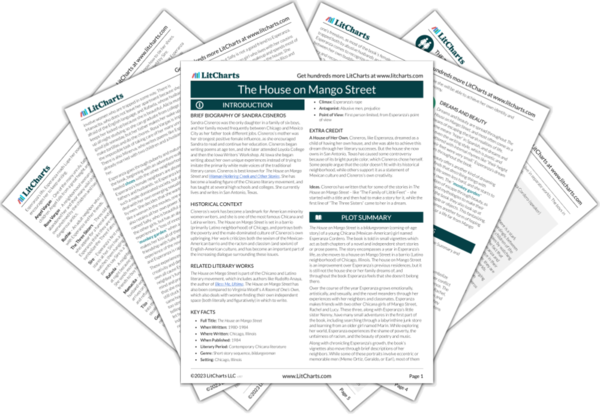Language and Names
One of the most important themes of The House on Mango Street is the power of words. Esperanza first learns that the lack of language (especially English) means powerlessness, as with Mamacita, who is trapped in her apartment by her ignorance and fear of English. This leads to Esperanza understanding the power of controlling language, which first comes through the idea of names. Esperanza has only one name while most characters have several –…
read analysis of Language and NamesGender and Sexuality
From the start of the book Esperanza realizes that men and women live in “separate worlds,” and that women are nearly powerless in her society. There is a constant conflict between being a sexual being and keeping one’s freedom, as most of the book’s female characters are trapped both by abusive husbands and needy children. Esperanza comes to recognize this dichotomy as she is caught between her own budding sexuality and her desire for freedom.
…
read analysis of Gender and SexualityForeigness and Society
The House on Mango Street is set in a Latino community in Chicago, and on one level it is about building a cultural identity in a society where Latinos are seen as foreign. Throughout the book, Esperanza must struggle against the feelings of shame and isolation that come with living in the barrio – she is ashamed of her shabby house and how her classmates see her as “different.” Cathy, her first friend in…
read analysis of Foreigness and Society
Identity and Autonomy
Esperanza’s essential goal is to be an autonomous individual who controls her own choices, a desire driven by her observations of the many trapped and powerless people of Mango Street. This desire is physically represented by her dream of a new house in a different place – at first it is a house for her family, but by the story’s end it is a house that she alone owns, where she can write. She…
read analysis of Identity and AutonomyDreams and Beauty
Dreams and beauty are spread throughout The House on Mango Street, and most often come as a means of escaping the harsh realities of life. Esperanza’s name means “hope” in Spanish, and dreams and beauty pervade even the writing style, which is poetic and dreamlike and scattered with internal rhymes like “their height was not tall, and their feet were very small.” Esperanza’s dream of a house also recurs throughout the book.
The…
read analysis of Dreams and Beauty











